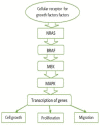Aetiology and Pathogenesis of Cutaneous Melanoma: Current Concepts and Advances
- PMID: 34203771
- PMCID: PMC8232613
- DOI: 10.3390/ijms22126395
Aetiology and Pathogenesis of Cutaneous Melanoma: Current Concepts and Advances
Abstract
Melanoma develops from malignant transformations of the pigment-producing melanocytes. If located in the basal layer of the skin epidermis, melanoma is referred to as cutaneous, which is more frequent. However, as melanocytes are be found in the eyes, ears, gastrointestinal tract, genitalia, urinary system, and meninges, cases of mucosal melanoma or other types (e.g., ocular) may occur. The incidence and morbidity of cutaneous melanoma (cM) are constantly increasing worldwide. Australia and New Zealand are world leaders in this regard with a morbidity rate of 54/100,000 and a mortality rate of 5.6/100,000 for 2015. The aim of this review is to consolidate and present the data related to the aetiology and pathogenesis of cutaneous melanoma, thus rendering them easier to understand. In this article we will discuss these problems and the possible impacts on treatment for this disease.
Keywords: aetiology; melanoma; pathogenesis; skin melanoma.
Conflict of interest statement
The authors declare no conflict of interest.
Figures



References
Publication types
MeSH terms
LinkOut - more resources
Full Text Sources
Medical

